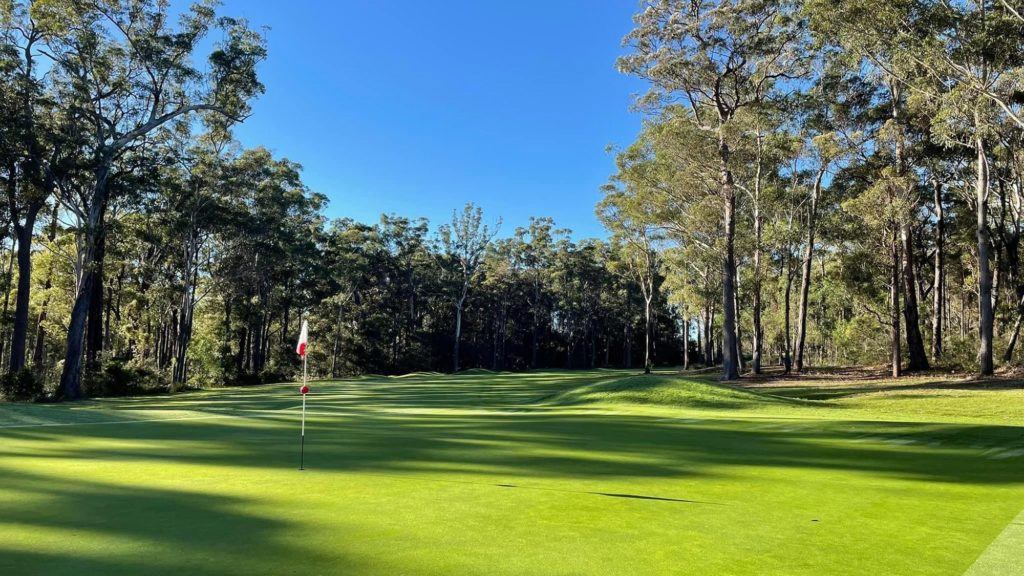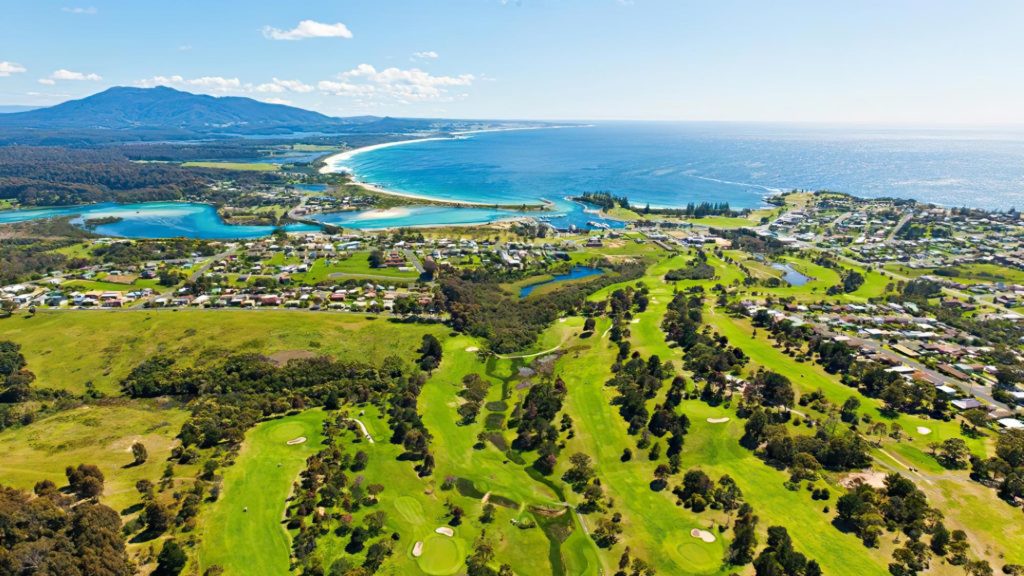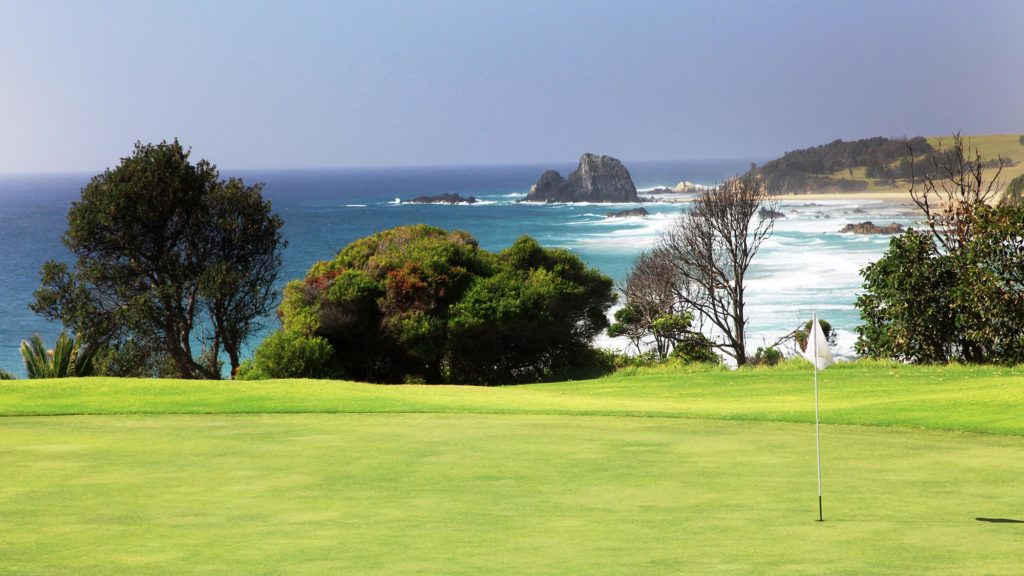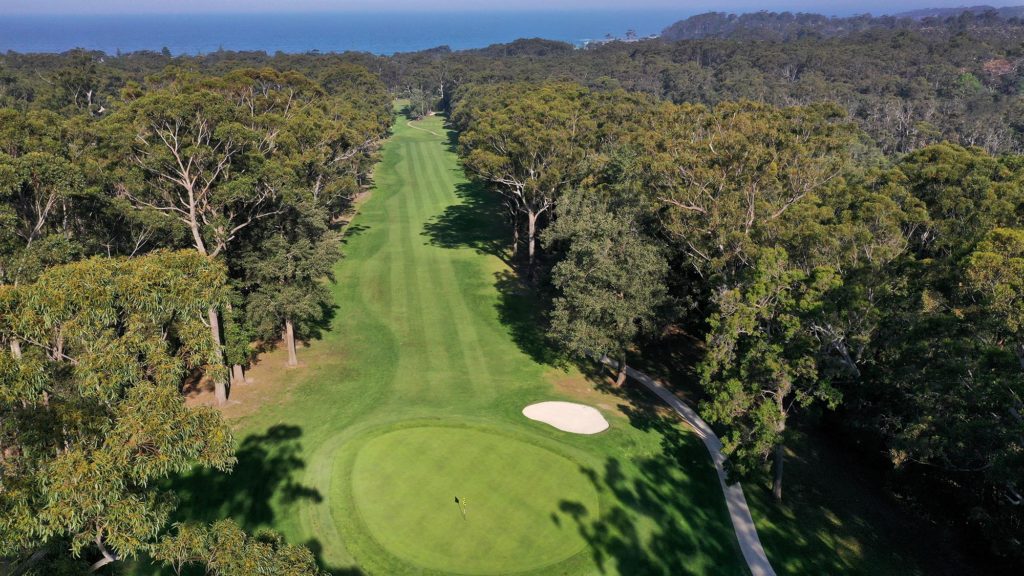Having suffered six years of challenges that would crush many regional destinations, Merimbula and the NSW Sapphire Coast have shown resilience beyond belief.
‘To hell and back’ would be a pertinent catchphrase for the Sapphire Coast. The past six years has seen its towns and regions endure severe drought (2016-2019), horrific bushfires (2019/2020), a fear-mongering COVID pandemic (March 2020-2022), sudden border closures (2020-2021) and flooding rains (2022). A quadruple-bogey.
Merimbula is the heart of the Sapphire Coast, almost equidistant from Sydney and Melbourne. Geographically, the New South Wales region encompasses the Bega Valley, the seaside townships of Bermagui, Tathra, Tura Beach, Merimbula, Pambula and Eden, and beyond to the Victorian border. The relatively small population of 35,000 belies its immense natural beauty.
Local businesses – reliant on tourism – have been devastated by recent events. Many have had to re-invent themselves post-COVID. The golf market is relatively over-supplied with six courses within one hour’s drive. Hence, the reliance on tourism for revenue.
In its heyday, the 27-hole Pambula Merimbula Golf Club would attract six to eight busloads of Victorians to play the club’s 150 poker machines. But its fortunes changed dramatically after a multi-million clubhouse extension prior to the Global Financial Crisis in 2008, according to club president Jeanette Hall.

A lengthy drought followed by bushfires in the summer of 2019/2020 put the club in dire financial straits. To ensure money in the bank, the club sold off land once envisaged to accommodate another nine holes. Then with patronage and revenue diminishing after COVID and Victorian border closures, Pambula Merimbula made the heartfelt decision to shut its clubhouse in August 2021. The bar/cafe remain open to service up to 100 golfers in what is regarded as the ‘28th Hole’.
Despite the setbacks, Pambula Merimbula continues its ascension as one of the finest golf facilities in regional NSW. The ‘Sapphire’ layout (holes 10-27) is the pick of the routing configurations (5,992 metres, par 73). Its short, dogleg par-4s wouldn’t feel out of place at Kingston Heath or Woodlands on the Melbourne Sandbelt. Tall native gums adorned by dense thickets of fern resemble the colourful bracken/heathland of Royal Hobart. And the vistas between gaps in vegetation tend to draw comparisons with Bonville.
Pambula Merimbula’s cushioned kikuyu fairways could be mistaken for carpet if not for the prevalence of kangaroo ‘pellets’ from the 1,000-strong mob of Eastern Greys inhabiting the property. It’s not unusual for golfers to have a gallery of 50 or so ’roos – hence a fist pump or “C’mon” is warranted upon sinking any putt of substance.
Credit for Pambula Merimbula’s emergence as a polished jewel should be directed towards superintendent Pat Wilson, who has undertaken an extensive native tree and vegetation masterplan. During his 11-year tenure Wilson has removed numerous ‘exotics’ and enhanced landscaping by utilising an eight-strong greenkeeping crew and volunteer gardening group of members.
Pambula Merimbula’s green fee is superb value at $55. Locals pay a full-playing membership fee of $1,092 per annum (plus $5 per social round and $18 competition fee). If located in Sydney, Pambula Merimbula would be a top-10 facility and golfers wouldn’t blink at membership dues upwards of $3,000
per annum.
A post-round meal beckons across the road at Wheeler’s Oysters. Its restaurant offers fine dining while the cafe caters for eat-in and takeaway. (For example, a six-oyster/six-prawn pack is $21.) The award-winning, family-run business also has daily tours of its oyster farm.
For something off the beaten track, The Oyster Barn just off the Princes Highway at Millingandi is a ‘farm gate’ where you can eat freshly shucked Sydney Rock oysters on the deck overlooking the mangroves of Merimbula Lake.
Apart from oysters, Sapphire Coast Tourism tends to focus on environmental tourism, bushwalking, kayaking and, of course, whale watching. Peak season is September to late November and there are numerous vantage points on land and at sea on which to see migrating humpback and southern right whales.

Merimbula has plenty of family attractions (escapetomerimbula.com.au). Fishpen opposite the town centre between Merimbula Lake and Main Beach has accommodation and playgrounds to explore. The Merimbula Boardwalk (3.4 kilometres) and new Lake Explorer Pathway (1.3 kilometres) can be walked or ridden.
Magic Mountain Amusement Park prides itself as a park that caters for all ages with a focus on classic rides. It has the only rollercoaster between Sydney and Melbourne as well as two waterslides, tube rider, carpet slide, toboggan run, grand prix cars (go-karts), jumping castles, Colorbond maze, dinosaur park, mini-golf and a treetop climb. Entry prices: $52 (5-12 years), $59 (13-59 years), $34 (60+ years).
In the event of wet weather, Top Fun in Merimbula has video games, ten-pin bowling, laser tag and mini-golf. Merimbula Aquarium and Wharf Restaurant (merimbulawharf.com.au) has a 70,000-litre ‘Oceanarium’ with 28 tanks. It’s open from 10am to 4pm (Wednesday to Sunday) with fish feeding at 11.30am (Wednesdays and Fridays).
Potoroo Palace, named after the cute rat-like marsupial, is a native sanctuary with more than 100 animal species ($25 adult/$16 child). It’s a not-for-profit rather than a zoo and many of the animals are rescues. Bookings are available for encounters with potoroos, koala, wombat, echidna, bettong, white-winged chough, curlews, possum and python.
Big boys golf
Tura Beach Country Club (6,018 metres, par 73) on Merimbula’s northern perimeter couldn’t be more of a contrast to its rival on the other side of town. The Thomson Wolveridge design opened in 1982 as part of a residential development of the same name. Tura Beach is a ‘big boys’ golf course with startling elevation changes, requiring robust tee shots to plateaued fairways and daring approaches over cavernous greenside bunkers.
The first six holes are brilliantly routed from the clubhouse down to marshland around Tura Beach. They feature three of the layout’s six par 5s. Lingering in the memory bank are the approach to the semi-island par-5 second, the sound of pounding waves upon reaching the fourth tee and an
all-water carry to the green from the rear tee at the 181-metre fifth. Capping off a round, Tura Beach’s grand clubhouse is perched like a castle in the sky from which golfers can savour ‘million-dollar views’ of the Pacific Ocean.
Less daunting golf awaits at the relatively benign Bega Country Club, Tathra Golf Country Club (14 holes) and Eden Golf & Country Club.
Bermagui Country Club (5,581 metres, par 72) is where Hall of Famer Laura Davies prevailed in a playoff to win an ALPG event in 2001. Bermagui is a typical under-rated country track with wide fairways and small greens. Apart from the opening and closing holes (one, nine, 10, 18) on low-lying tidal flats, Bermagui is undulating in keeping with the rolling countryside of Central Tilba, the location for TV series River Cottage Australia that championed organic food and local produce. Fresh seafood can be enjoyed across the road at Bermagui Fisherman’s Wharf where local trawlers are major suppliers to the Sydney Fish Market.

Absence makes the heart grow fonder
It would be remiss to exclude Narooma Golf Club from a Sapphire Coast itinerary. Just 30 minutes from Bermagui (and 85 minutes from Merimbula), Narooma is marketed under the Eurobodalla Coast banner. That’s a shame considering Narooma Golf Club was immortalised by a television commercial featuring Paul Hogan who failed to clear the rocky chasm on its par-3 third hole.
Narooma’s first six holes skirt the coastline and wow the senses with the unique rocky outcrops that lure geologists from afar. These first six are simply breathtaking and form part of Narooma’s original nine (along with holes seven, 17 and 18).
Some 28 years since first playing Narooma (5,804 metres, par 72), it’s apparent the southern-most nine (holes eight to 16) hadn’t left much of an impression. Perhaps the unceremonious passage to the eighth tee through a dilapidated caravan park had left a sour taste. But in all likelihood a rickety golf swing had dulled the appreciation.
These ‘newer’ southern holes are actually better designed than the picture-postcard holes on the front side. They pose a quintessential woodland challenge. And four of these holes (eight, nine, 15, 16) lie on flatter terrain around a tidal inlet, offering a genuine Sandbelt experience.
“I really love the way this course is set out. Every single hole is different, there’s no repetition of any other hole at all,” says Narooma Golf Club general manager Dominic Connaughton. “And you play two-in-one [round]. You’re playing a linksy course on the front nine and when you go out for the back nine holes it’s a foresty, timberland course.”
Ranked No.85 on Australia’s Top 100 Golf Courses, Narooma is a fascinating ‘Tale Of Two Nines’. Incidentally, that dilapidated trailer park has been transformed into spacious beachfront cabins and campsites at the rebranded Surf Beach Holiday Park.
Oysters, seafood, whale watching and golf. It’s an irrepressible combination that can withstand whatever Mother Nature throws at the Sapphire Coast.

Shoalhaven surprise
The six-hour journey from Sydney to Merimbula offers an array of playing opportunities along the NSW South Coast, the best of which may lie in the Shoalhaven. Mollymook Golf Club’s Hilltop course has been luring intrepid golfers long before 2009 when celebrated TV chef Rick Stein popularised the coastal retreat with his award-winning restaurant at Bannisters by the Sea.
Since the 1970s, Mollymook’s Hilltop layout (6,225 metres, par 72) has maintained a strong reputation despite lacking the association of a renowned golf course architect (visitor green fee: $69 midweek/$79 weekend). Currently ranked No.92 on Australia’s Top 100 Golf Courses, it flourished on the strength of the original design by Ken McKay with minimal investment.
The front nine is reasonably flat (apart from holes one and eight) while the back nine is routed through bushland and is quite undulating. Visitors tend to ask if they should hire a cart for the round, which is the cue for a running joke: “It’s not called Hilltop for nothing,” says Mollymook golf manager Barry West.
Celebrating its 70th anniversary in 2022, the club has bounced back from struggling with a large debt a decade ago to a very strong financial position and is now able to reinvest back into its assets. The club spent more than $1 million on Mollymook’s Beachside course last year and is now working towards its long-term masterplan on the Hilltop to add new cartpaths, fix drainage issues and gradually rebuild tees, greens and surrounds.
The reopened Beachside course (1,200 metres, par 28) is ideal for introducing beginners and kids to the game. Justin Trott, general manager of Programmed Turnpoint (and vice-president of the Society of Australian Golf Course Architects) solved safety issues by removing length from the original layout, which measured 2,102 metres with a par of 33.
Elsewhere, Gerringong Golf Club with its wide-open fairways and scarcity of trees is perfect for less-accomplished players. It boasts stunning views of the Pacific Ocean from every tee and every green.
In Nowra, Worrigee Links (5,374 metres, par 70) is a score-friendly venue. The course, designed by Ken McKay Jnr, opened in 2005 and is a links-style course built around the edges of native wetlands. Three driveable par 4s (279, 242 and 280 metres) are countered by three tough par 3s (202, 175 and 185 metres).
Worrigee Links is manicured to perfection, says club professional Greg Drummond: “It’s not long on length but our defence here is the open nature of the property, exposed to the westerly winds. We do have very big green complexes and we’re renowned as having the best putting surfaces on the South Coast.”
The course has prospered from ownership by Shoalhaven Ex-Servicemen’s Club, which acquired farmland on the current site and built the Worrigee Sports club. On-site accommodation at Springs Shoalhaven features views of surrounding farmland and the Illawarra escarpment. Guests have access to an infinity pool, the sports club’s facilities and a fine-dining restaurant. ‘The Growers’ showcases locally sourced organic food and is based on The Grounds in Sydney’s Alexandria. Just 45 minutes from Mollymook, Springs Shoalhaven is a wise play-and-stay option given the dearth of good rental accommodation in and around Ulladulla.



